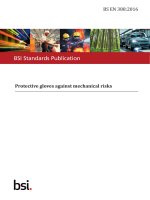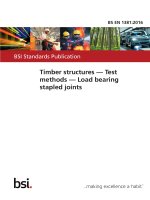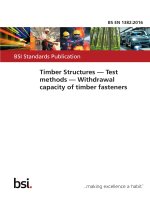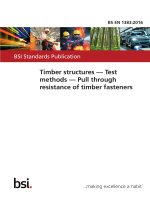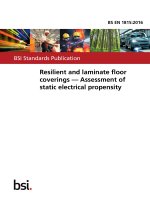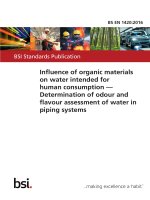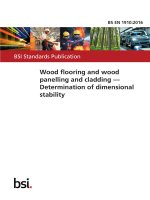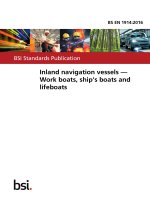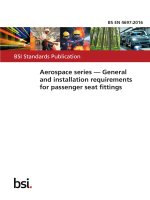Bsi bs en 62108 2016
Bạn đang xem bản rút gọn của tài liệu. Xem và tải ngay bản đầy đủ của tài liệu tại đây (3.72 MB, 54 trang )
BS EN 62108:2016
BSI Standards Publication
Concentrator photovoltaic
(CPV) modules and assemblies —
Design qualification and type
approval
BRITISH STANDARD
BS EN 62108:2016
National foreword
This British Standard is the UK implementation of EN 62108:2016. It is
identical to IEC 62108:2016. It supersedes BS EN 62108:2008 which is
withdrawn.
The UK participation in its preparation was entrusted to Technical
Committee GEL/82, Photovoltaic Energy Systems.
A list of organizations represented on this committee can be obtained on
request to its secretary.
This publication does not purport to include all the necessary provisions of
a contract. Users are responsible for its correct application.
© The British Standards Institution 2017.
Published by BSI Standards Limited 2017
ISBN 978 0 580 89554 8
ICS 27.160
Compliance with a British Standard cannot confer immunity from
legal obligations.
This British Standard was published under the authority of the
Standards Policy and Strategy Committee on 31 January 2017.
Amendments/corrigenda issued since publication
Date
Text affected
BS EN 62108:2016
EUROPEAN STANDARD
EN 62108
NORME EUROPÉENNE
EUROPÄISCHE NORM
December 2016
ICS 27.160
Supersedes EN 62108:2008
English Version
Concentrator photovoltaic (CPV) modules and assemblies Design qualification and type approval
(IEC 62108:2016)
Modules et ensembles photovoltaïques à concentration Qualification de la conception et homologation
(IEC 62108:2016)
Konzentrator-Photovoltaik(CPV)-Module und -Anordnungen Bauarteignung und Bauartzulassung
(IEC 62108:2016)
This European Standard was approved by CENELEC on 2016-10-31. CENELEC members are bound to comply with the CEN/CENELEC
Internal Regulations which stipulate the conditions for giving this European Standard the status of a national standard without any alteration.
Up-to-date lists and bibliographical references concerning such national standards may be obtained on application to the CEN-CENELEC
Management Centre or to any CENELEC member.
This European Standard exists in three official versions (English, French, German). A version in any other language made by translation
under the responsibility of a CENELEC member into its own language and notified to the CEN-CENELEC Management Centre has the
same status as the official versions.
CENELEC members are the national electrotechnical committees of Austria, Belgium, Bulgaria, Croatia, Cyprus, the Czech Republic,
Denmark, Estonia, Finland, Former Yugoslav Republic of Macedonia, France, Germany, Greece, Hungary, Iceland, Ireland, Italy, Latvia,
Lithuania, Luxembourg, Malta, the Netherlands, Norway, Poland, Portugal, Romania, Slovakia, Slovenia, Spain, Sweden, Switzerland,
Turkey and the United Kingdom.
European Committee for Electrotechnical Standardization
Comité Européen de Normalisation Electrotechnique
Europäisches Komitee für Elektrotechnische Normung
CEN-CENELEC Management Centre: Avenue Marnix 17, B-1000 Brussels
© 2016 CENELEC All rights of exploitation in any form and by any means reserved worldwide for CENELEC Members.
Ref. No. EN 62108:2016 E
BS EN 62108:2016
EN 62108:2016
European foreword
The text of document 82/1142/FDIS, future edition 2 of IEC 62108, prepared by IEC/TC 82 "Solar
photovoltaic energy systems" was submitted to the IEC-CENELEC parallel vote and approved by
CENELEC as EN 62108:2016.
The following dates are fixed:
•
latest date by which the document has to be implemented at
national level by publication of an identical national
standard or by endorsement
(dop)
2017-07-31
•
latest date by which the national standards conflicting with
the document have to be withdrawn
(dow)
2019-10-31
This document supersedes EN 62108:2008.
Attention is drawn to the possibility that some of the elements of this document may be the subject of
patent rights. CENELEC [and/or CEN] shall not be held responsible for identifying any or all such
patent rights.
Endorsement notice
The text of the International Standard IEC 62108:2016 was approved by CENELEC as a European
Standard without any modification.
2
BS EN 62108:2016
EN 62108:2016
Annex ZA
(normative)
Normative references to international publications
with their corresponding European publications
The following documents, in whole or in part, are normatively referenced in this document and are
indispensable for its application. For dated references, only the edition cited applies. For undated
references, the latest edition of the referenced document (including any amendments) applies.
NOTE 1
When an International Publication has been modified by common modifications, indicated by (mod),
the relevant EN/HD applies.
NOTE 2
Up-to-date information on the latest versions of the European Standards listed in this annex is
available here: www.cenelec.eu.
Publication
Year
Title
EN/HD
Year
IEC 60068-2-21
2006
Environmental testing Part 2-21: Tests - Test U: Robustness of
terminations and integral mounting
devices
EN 60068-2-21
2006
IEC 60529
-
Degrees of protection provided by
enclosures (IP Code)
EN 60529
-
IEC 61215-2
2016
Terrestrial photovoltaic (PV) modules Design qualification and type approval Part 2: Test procedures
EN 61215-2
2016
IEC 62670-1
-
Photovoltaic concentrators (CPV) Performance testing Part 1: Standard conditions
EN 62670-1
-
ANSI/UL 1703
2002
Flat-Plate Photovoltaic Modules and
Panels
-
-
3
–2–
BS EN 62108:2016
IEC 62108:2016 © IEC 2016
CONTENTS
FOREWORD ......................................................................................................................... 5
1
Scope and object ........................................................................................................... 7
2
Normative references..................................................................................................... 7
3
Terms and definitions .................................................................................................... 7
4
Sampling ....................................................................................................................... 9
5
Marking ....................................................................................................................... 10
6
Testing ........................................................................................................................ 10
7
Pass criteria ................................................................................................................ 11
8
Report ......................................................................................................................... 18
9
Modifications ............................................................................................................... 19
10
Test procedures .......................................................................................................... 19
10.1 Visual inspection ................................................................................................. 19
10.1.1
General ....................................................................................................... 19
10.1.2
Procedure .................................................................................................... 19
10.1.3
Major visual defects ..................................................................................... 20
10.1.4
Requirements .............................................................................................. 20
10.2 Electrical performance measurement ................................................................... 20
10.2.1
Purpose ....................................................................................................... 20
10.2.2
Outdoor side-by-side I-V measurement ......................................................... 20
10.2.3
Solar simulator I-V measurement .................................................................. 22
10.2.4
Dark I-V measurement ................................................................................. 22
10.3 Ground path continuity test .................................................................................. 23
10.3.1
General ....................................................................................................... 23
10.3.2
Purpose ....................................................................................................... 23
10.3.3
Procedure .................................................................................................... 23
10.3.4
Requirements .............................................................................................. 23
10.4 Electrical insulation test ...................................................................................... 24
10.4.1
Purpose ....................................................................................................... 24
10.4.2
Procedure .................................................................................................... 24
10.4.3
Requirements .............................................................................................. 24
10.5 Wet insulation test ............................................................................................... 25
10.5.1
Purpose ....................................................................................................... 25
10.5.2
Procedure .................................................................................................... 25
10.5.3
Requirements .............................................................................................. 25
10.6 Thermal cycling test ............................................................................................ 25
10.6.1
Purpose ....................................................................................................... 25
10.6.2
Test sample ................................................................................................. 26
10.6.3
Procedure .................................................................................................... 26
10.6.4
Requirements .............................................................................................. 27
10.7 Damp heat test .................................................................................................... 28
10.7.1
Purpose ....................................................................................................... 28
10.7.2
Test sample ................................................................................................. 28
10.7.3
Procedure .................................................................................................... 28
10.7.4
Requirements .............................................................................................. 29
10.8 Humidity freeze test ............................................................................................ 29
BS EN 62108:2016
IEC 62108:2016 © IEC 2016
–3–
10.8.1
Purpose ....................................................................................................... 29
10.8.2
Test sample ................................................................................................. 29
10.8.3
Procedure .................................................................................................... 29
10.8.4
Requirements .............................................................................................. 29
10.9 Hail impact test ................................................................................................... 30
10.9.1
Purpose ....................................................................................................... 30
10.9.2
Apparatus .................................................................................................... 30
10.9.3
Procedure .................................................................................................... 31
10.9.4
Requirements .............................................................................................. 31
10.10 Water spray test .................................................................................................. 31
10.10.1 General ....................................................................................................... 31
10.10.2 Purpose ....................................................................................................... 31
10.10.3 Procedure .................................................................................................... 32
10.10.4 Requirements .............................................................................................. 32
10.11 Bypass/blocking diode thermal test ...................................................................... 32
10.11.1 Purpose ....................................................................................................... 32
10.11.2 Test sample ................................................................................................. 33
10.11.3 Apparatus .................................................................................................... 33
10.11.4 Procedure .................................................................................................... 33
10.11.5 Requirements .............................................................................................. 33
10.11.6 Procedure 2 – Alternate method ................................................................... 34
10.12 Robustness of terminations test ........................................................................... 35
10.12.1 Purpose ....................................................................................................... 35
10.12.2 Types of terminations ................................................................................... 35
10.12.3 Procedure .................................................................................................... 35
10.12.4 Requirements .............................................................................................. 36
10.13 Mechanical load test ........................................................................................... 36
10.13.1 Purpose ....................................................................................................... 36
10.13.2 Procedure .................................................................................................... 37
10.13.3 Requirements .............................................................................................. 37
10.14 Off-axis beam damage test .................................................................................. 37
10.14.1 General ....................................................................................................... 37
10.14.2 Purpose ....................................................................................................... 37
10.14.3 Special case ................................................................................................ 37
10.14.4 Procedure .................................................................................................... 37
10.14.5 Requirements .............................................................................................. 38
10.15 Outdoor exposure test ......................................................................................... 38
10.15.1 Purpose ....................................................................................................... 38
10.15.2 Procedure .................................................................................................... 38
10.15.3 Requirements .............................................................................................. 38
10.16 Hot-spot endurance test ...................................................................................... 39
10.17 Dust ingress protection test ................................................................................. 39
10.17.1 Purpose ....................................................................................................... 39
10.17.2 Procedure .................................................................................................... 39
10.17.3 Requirements .............................................................................................. 39
Annex A (informative) Summary of test conditions and requirements ................................... 40
Annex B (normative) Retesting guideline ............................................................................ 43
B.1
Product or process modifications requiring limited retesting to maintain
certification ......................................................................................................... 43
–4–
B.2
B.3
B.4
B.5
B.6
B.7
B.8
B.9
B.10
B.11
B.12
B.13
B.14
B.15
B.16
BS EN 62108:2016
IEC 62108:2016 © IEC 2016
Modifications of CPV cell technology ................................................................... 43
Modifications in optical encapsulation on the cell (Includes optical coupling
between the cell and a glass secondary optical element bonded to the cell) ......... 44
Modification in cell encapsulation outside of intended light path ........................... 44
Modification of cell package substrate used for heat transfer ................................ 44
Accessible optics (primary or secondary) ............................................................. 45
Inaccessible optics (secondary) ........................................................................... 45
Frame and/or mounting structure ......................................................................... 45
Enclosure............................................................................................................ 46
Wiring compartment/junction box ......................................................................... 46
Interconnection terminals .................................................................................... 46
Interconnection materials or technique (to cells and between receivers) ............... 47
Change in electrical circuit design in an identical package ................................... 47
Output power ...................................................................................................... 47
Thermal energy transfer means ........................................................................... 48
Adhesives ........................................................................................................... 48
Figure 1 – Schematic of point-focus dish PV concentrator .................................................... 12
Figure 2 – Schematic of linear-focus trough PV concentrator ............................................... 13
Figure 3 – Schematic of point-focus fresnel lens PV concentrator ........................................ 14
Figure 4 – Schematic of linear-focus fresnel lens PV concentrator ....................................... 15
Figure 5 – Schematic of a heliostat CPV .............................................................................. 16
Figure 6 – Qualification test sequence for CPV modules ...................................................... 17
Figure 7 – Qualification test sequence for CPV assemblies .................................................. 18
Figure 8 – Temperature and current profile of thermal cycle test (not to scale) ..................... 28
Figure 9 – Profile of humidity-freeze test conditions ............................................................. 30
Figure 10 – Bypass diode thermal test ................................................................................. 34
Table 1 – Terms used for CPV .............................................................................................. 9
Table 2 – Allocation of test samples to typical test sequences ............................................. 11
Table 3 – Thermal cycle test options for sequence A ........................................................... 27
Table 4 – Humidity freeze test options for sequence B ......................................................... 29
Table 5 – Minimum wind loads ............................................................................................ 36
Table A.1 – Summary of test conditions and requirements ................................................... 40
BS EN 62108:2016
IEC 62108:2016 © IEC 2016
–5–
INTERNATIONAL ELECTROTECHNICAL COMMISSION
____________
CONCENTRATOR PHOTOVOLTAIC (CPV) MODULES AND ASSEMBLIES –
DESIGN QUALIFICATION AND TYPE APPROVAL
FOREWORD
1) The International Electrotechnical Commission (IEC) is a worldwide organization for standardization comprising
all national electrotechnical committees (IEC National Committees). The object of IEC is to promote
international co-operation on all questions concerning standardization in the electrical and electronic fields. To
this end and in addition to other activities, IEC publishes International Standards, Technical Specifications,
Technical Reports, Publicly Available Specifications (PAS) and Guides (hereafter referred to as “IEC
Publication(s)”). Their preparation is entrusted to technical committees; any IEC National Committee interested
in the subject dealt with may participate in this preparatory work. International, governmental and nongovernmental organizations liaising with the IEC also participate in this preparation. IEC collaborates closely
with the International Organization for Standardization (ISO) in accordance with conditions determined by
agreement between the two organizations.
2) The formal decisions or agreements of IEC on technical matters express, as nearly as possible, an international
consensus of opinion on the relevant subjects since each technical committee has representation from all
interested IEC National Committees.
3) IEC Publications have the form of recommendations for international use and are accepted by IEC National
Committees in that sense. While all reasonable efforts are made to ensure that the technical content of IEC
Publications is accurate, IEC cannot be held responsible for the way in which they are used or for any
misinterpretation by any end user.
4) In order to promote international uniformity, IEC National Committees undertake to apply IEC Publications
transparently to the maximum extent possible in their national and regional publications. Any divergence
between any IEC Publication and the corresponding national or regional publication shall be clearly indicated in
the latter.
5) IEC itself does not provide any attestation of conformity. Independent certification bodies provide conformity
assessment services and, in some areas, access to IEC marks of conformity. IEC is not responsible for any
services carried out by independent certification bodies.
6) All users should ensure that they have the latest edition of this publication.
7) No liability shall attach to IEC or its directors, employees, servants or agents including individual experts and
members of its technical committees and IEC National Committees for any personal injury, property damage or
other damage of any nature whatsoever, whether direct or indirect, or for costs (including legal fees) and
expenses arising out of the publication, use of, or reliance upon, this IEC Publication or any other IEC
Publications.
8) Attention is drawn to the Normative references cited in this publication. Use of the referenced publications is
indispensable for the correct application of this publication.
9) Attention is drawn to the possibility that some of the elements of this IEC Publication may be the subject of
patent rights. IEC shall not be held responsible for identifying any or all such patent rights.
International Standard IEC 62108 has been prepared by IEC technical committee 82: Solar
photovoltaic energy systems.
This second edition cancels and replaces the first edition, issued in 2007. It constitutes a
technical revision.
The main technical changes with regard to the previous edition are as follows:
a) Changes in outdoor exposure from 1000 h to 500 h.
b) Changes in current cycling during thermal cycling test.
c) Added dust ingress test.
d) Eliminated thermal cycling associated with damp heat test.
e) Eliminated UV exposure test.
BS EN 62108:2016
IEC 62108:2016 © IEC 2016
–6–
The text of this standard is based on the following documents:
FDIS
Report on voting
82/1142/FDIS
82/1161/RVD
Full information on the voting for the approval of this standard can be found in the report on
voting indicated in the above table.
This publication has been drafted in accordance with the ISO/IEC Directives, Part 2.
The committee has decided that the contents of this publication will remain unchanged until
the stability date indicated on the IEC website under "" in the data
related to the specific publication. At this date, the publication will be
•
reconfirmed,
•
withdrawn,
•
replaced by a revised edition, or
•
amended.
BS EN 62108:2016
IEC 62108:2016 © IEC 2016
–7–
CONCENTRATOR PHOTOVOLTAIC (CPV) MODULES AND ASSEMBLIES –
DESIGN QUALIFICATION AND TYPE APPROVAL
1
Scope and object
This International Standard specifies the minimum requirements for the design qualification
and type approval of concentrator photovoltaic (CPV) modules and assemblies suitable for
long-term operation in general open-air climates as defined in IEC 60721-2-1. The test
sequence is partially based on that specified in IEC 61215-1 for the design qualification and
type approval of flat-plate terrestrial crystalline silicon PV modules. However, some changes
have been made to account for the special features of CPV receivers and modules,
particularly with regard to the separation of on-site and in-lab tests, effects of tracking
alignment, high current density, and rapid temperature changes, which have resulted in the
formulation of some new test procedures or new requirements.
The object of this test standard is to determine the electrical, mechanical, and thermal
characteristics of the CPV modules and assemblies and to show, as far as possible within
reasonable constraints of cost and time, that the CPV modules and assemblies are capable of
withstanding prolonged exposure in climates described in the scope. The actual life of CPV
modules and assemblies so qualified will depend on their design, production, environment,
and the conditions under which they are operated.
This standard shall be used in conjunction with the retest guidelines described in Annex B.
2
Normative references
The following documents, in whole or in part, are normatively referenced in this document and
are indispensable for its application. For dated references, only the edition cited applies. For
undated references, the latest edition of the referenced document (including any
amendments) applies.
IEC 60068-2-21:2006, Environmental testing – Part 2-21: Tests – Test U: Robustness of
terminations and integral mounting devices
IEC 60529, Degrees of protection provided by enclosures (IP Code)
IEC 61215-2:2016, Terrestrial photovoltaic (PV) modules – Design qualification and type
approval – Part 2: Test procedures
IEC 62670-1, Photovoltaic concentrators (CPV) – Performance testing – Part 1: Standard
conditions
ANSI/UL 1703:2002, Standard for Safety: Flat-Plate Photovoltaic Modules and Panels
3
Terms and definitions
For the purposes of this document, the following terms and definitions apply. See also Table 1.
3.1
concentrator
term associated with photovoltaic devices that use concentrated sunlight
–8–
BS EN 62108:2016
IEC 62108:2016 © IEC 2016
3.2
concentrator cell
basic photovoltaic device that is used under the illumination of concentrated sunlight
3.3
concentrator optics
optical device that performs one or more of the following functions from its input to output:
increasing the light intensity, filtering the spectrum, modifying light intensity distribution, or
changing light direction. Typically, it is a lens or a mirror
Note 1 to entry: A primary optics receives unconcentrated sunlight directly from the sun. A secondary optics
receives concentrated or modified sunlight from another optical device, such as primary optics or another
secondary optics.
3.4
concentrator receiver
group of one or more concentrator cells and secondary optics (if present) that accepts
concentrated sunlight and incorporates the means for thermal and electric energy transfer. A
receiver could be made of several sub-receivers. The sub-receiver is a physically stand-alone,
smaller portion of the full-size receiver
3.5
concentrator module
group of receivers, optics, and other related components, such as interconnection and
mounting, that accepts unconcentrated sunlight. All above components are usually
prefabricated as one unit, and the focus point is not field adjustable
Note 1 to entry: A module could be made of several sub-modules. The sub-module is a physically stand-alone,
smaller portion of the full-size module.
3.6
concentrator assembly
group of receivers, optics, and other related components, such as interconnection and
mounting, that accepts unconcentrated sunlight. All above components would usually be
shipped separately and need some field installation, and the focus point is field adjustable
Note 1 to entry: An assembly could be made of several sub-assemblies. The sub-assembly is a physically standalone, smaller portion of the full-size assembly.
3.7
control unit
hardware that is not stressed, but is included in each measurement to enable greater
confidence in consistent measurements
BS EN 62108:2016
IEC 62108:2016 © IEC 2016
–9–
Table 1 – Terms used for CPV
Primary optics
CPV Module –
prefabricated and
the focus point is not field
adjustable, such as most
Fresnel lens systems
Secondary optics
CPV cells
Electric energy
transfer means
CPV receiver
Thermal energy
transfer means
Interconnection
CPV Assembly –
needs some field
installation and the focus
point is field adjustable,
such as most reflective
systems
Mounting
IEC
4
Sampling
Figures 1 to 5 are schematics of cells, receivers, modules, and assemblies.
For non-field-adjustable focus-point CPV systems or modules, 7 modules and 2 receivers are
required to complete all the specified tests, plus one receiver for the bypass/blocking diode
thermal test (intrusive or non-intrusive). For details, see Figure 6. For field-adjustable focuspoint CPV systems or assemblies, 9 receivers (including secondary optics sections, if
applicable) and 7 primary optics sections are required to complete all the specified tests, plus
one receiver for the bypass/blocking diode thermal test (intrusive or non-intrusive). For details,
see Figure 7.
In the case that a full-size module or assembly is too large to fit into available testing
equipment, such as environmental chambers, or a full-size module or assembly is too
expensive (e.g., for a 20 kW reflective dish concentrator system, 9 receiver samples account
for 180 kW of PV cells), a smaller representative sample can be used. However, even if
representative samples are used for the other test, a full-size module or assembly shall be
installed and tested for outdoor exposure. This can be conducted either in the testing lab, or
through on-site witness.
Representative samples shall include all components, except some repeated parts. If possible,
the representative samples shall use sub-receivers, sub-modules, or sub-assemblies. During
the design and manufacturing of the representative samples, much attention shall be paid to
reach the maximum similarity to the full-size component in all electrical, mechanical, and
thermal characteristics related to quality and reliability.
Specifically, the cell string in representative samples shall be long enough to include at least
two bypass diodes, but in no case less than ten cells. The encapsulations, interconnects,
terminations, and the clearance distances around all edges shall be the same as on the actual
full-size products. Other representative components, including lens/housing joints,
receiver/housing joints, and end plate/lens shall also be included and tested.
Test samples should be taken at random from a production batch or batches. When the
samples to be tested are prototypes of a new design and not from production, or
representative samples are used, these facts should be noted in the test report (see Clause 8).
– 10 –
BS EN 62108:2016
IEC 62108:2016 © IEC 2016
The test samples shall have been manufactured from specified materials and components in
accordance with the relevant drawings and process instructions and should have been
subjected to the manufacturer’s normal inspection, quality control, and production acceptance
procedures. They shall be complete in every detail and should be accompanied by the
manufacturer’s handling, mounting, connection, and operation manuals. Samples shall not be
subjected to other special procedures that are not a part of standard production.
If the intrusive bypass/blocking diode thermal test is to be performed, an additional specially
manufactured receiver is required with extra electrical and thermal detector leads so that each
individual diode can be accessed separately.
5
Marking
Each receiver or module section shall carry the following clear and indelible markings:
–
Name, monogram, or symbol of manufacturer.
–
Type or model number.
–
Serial number.
–
Polarity of terminals or leads (color coding is permissible).
–
Maximum system voltage for which the module or assembly is suitable.
–
Nominal maximum output power and its tolerance at specified condition.
–
The date, place of manufacture, and cell materials shall be marked, or be traceable from
the serial number.
If representative samples are used, the same markings as on full-size products shall be
included for all tests, and the marking should be capable of surviving all test sequences.
6
Testing
If recommended by the manufacturer, before beginning the testing, all testing samples,
including the control module and control receiver, shall be exposed to the direct normal
irradiation (DNI) of sunlight (either natural or simulated) for a total of 5 kWh/m 2 to 5,5 kWh/m 2
while open circuited. This procedure is designed to reduce the initial photon degradation
effects.
In this standard all references to short-circuit current I sc , open-circuit voltage V oc , maximum
output power P m , are based on Concentrator Standard Test Condition (CSTC), which is
defined in IEC 62670-1. Alternatively, Concentrator Standard Operating Conditions (CSOC),
as defined in IEC 62670-1, may be used consistently.
The test samples shall be randomly divided into groups and subjected to the qualification test
sequences in Figure 6 or Figure 7. Test procedures and requirements are detailed in Clause
10, and summarized in Annex A. The allocation of test samples to typical test sequences is
given in Table 2.
After initial tests and inspections, one module or one receiver/mirror section shall be removed
from the test sequence as a control unit. Preferably, the control unit should be stored in the
dark at room temperature to reduce the electrical performance degradation, but it may be kept
outdoors with a dark cover. As shown in Figure 6 for modules or in Figure 7 for assemblies,
the test sequence is performed both in-lab and on-site. If the CPV receiver uses crystalline
silicon, a 1-sun measurement (flash or outdoor) can be used as a diagnostic tool throughout
the program. If the distance between these two locations is considerable or public shipping
companies are involved, a dark current-voltage (I-V) curve measurement before and after the
shipping should be performed to evaluate any possible changes on testing samples.
BS EN 62108:2016
IEC 62108:2016 © IEC 2016
– 11 –
If a particular manufacturer produces only specific components, such as receivers, lenses, or
mirrors, the design qualification and type approval testing can be conducted only on
applicable test sequences, and a partial certification can be issued independently.
If some test procedures in this standard are not applicable to a specific design configuration,
the manufacturer should discuss this with the certifying body and testing agency to develop a
comparable test program, based on the principles described in this standard. Any changes
and deviations shall be recorded and reported in details, as required in Clause 8 j).
Table 2 – Allocation of test samples to typical test sequences
Test
sequence
Module
receiver
Control
A
7
Assembly
module
receiver
mirror
1
1
1
2
2
B
2
2
2
C
2
2
2
D
1
1
1
E
1 (full-size)
1 (full-size)
1 (full-size)
F
1
Total
3
1
7
10
7
Pass criteria
A concentrator photovoltaic module or assembly design shall be judged to have passed the
qualification tests, and therefore to be IEC 62108 type approved, if each test sample meets all
the following criteria:
a) The relative power degradation in sequence A to D does not exceed 13 % if the I-V
measurement is under outdoor natural sunlight, or 8 % if the I-V measurement is under
solar simulator.
b) The relative power degradation in sequence E does not exceed 7 % for natural sunlight I-V
measurement, or 5 % for solar simulator I-V measurement, because the 1 000 kWh/m 2
DNI outdoor exposure test is not an accelerated stress test.
c) No sample has exhibited any open circuit during the tests.
d) There is no visual evidence of a major defect, as defined in 10.1.2.
e) The insulation test requirements are met at the beginning and the end of each sequence.
f)
The wet leakage current test requirements are met at the beginning and the end of each
sequence.
g) Specific requirements of the individual tests are met.
If there are some failures observed during the test, the following judgment and re-test
procedure shall apply:
h) If two or more test samples do not meet pass criteria, the design shall be deemed not to
have met the qualification requirements.
i)
Should one sample fail any test, another two samples meeting the requirements of Clause
4 could be subjected to the whole of the relevant test sequence from the beginning.
j)
In case i), if both samples pass the test sequence, the design shall be judged to have met
the qualification requirements.
k) In case i), if one or both of these samples also fail, the design shall be deemed not to
have met the qualification requirements.
BS EN 62108:2016
IEC 62108:2016 © IEC 2016
– 12 –
l)
In case h) or k), the entire test program illustrated in Figure 6 or Figure 7 shall be reperformed, usually after some design or processing improvement.
ASSEMBLY
Primary optics
Cooling tubes
RECEIVER
Secondary
optics mirrors
Solar cell
SUB-RECEIVER
02375604
Figure 1 – Schematic of point-focus dish PV concentrator
IEC
BS EN 62108:2016
IEC 62108:2016 © IEC 2016
– 13 –
ASSEMBLY
Heat sink
RECEIVER
Solar cell
02375607
Figure 2 – Schematic of linear-focus trough PV concentrator
IEC
BS EN 62108:2016
IEC 62108:2016 © IEC 2016
– 14 –
Modules
ARRAY
Tracker
mechanism
Rear view
Fresnel lens
parquets
MODULE
Primary (300X)
Fresnel lens
Solar cell
Reflective
secondary
Insulated
electrode
Solar cell
02375603
Heat
spreader
Module
back
RECEIVER
IEC
Figure 3 – Schematic of point-focus fresnel lens PV concentrator
BS EN 62108:2016
IEC 62108:2016 © IEC 2016
– 15 –
Module
02375605
Fresnel lens
Cross-section
Solar cell
Heat spreader
RECEIVER
Solar cell receiver
Figure 4 – Schematic of linear-focus fresnel lens PV concentrator
IEC
– 16 –
BS EN 62108:2016
IEC 62108:2016 © IEC 2016
Cooling fins
and fans
RECEIVER
Solar cells
ASSEMBLY
PRIMARY
OPTICS
02375606
IEC
Figure 5 – Schematic of a heliostat CPV
BS EN 62108:2016
IEC 62108:2016 © IEC 2016
START
Visual
7m+2r
– 17 –
7 modules (labeled as "m") and 2 receivers "r", at least one in full size, are required.
1 receiver specially constructed for intrusive bypass/blocking diode thermal test, when required.
10.1
On-site testing
In-lab testing
Elect. perf. SBS
10.2
7m+2r
Elect. perf. dark
5m+2r
10.2
Elect. perf. dark
5m+2r
If long-distance shipping is involved,
use dark I-V to evaluate any changes
10.2
Bypass/blocking
diode 1 r
Ground continuity
10.3
2m
Dry/wet insul
2m
Sequence F
1r
Ground continuity 10.3
5m+2r
10.4
10.5
Dry/wet insul
5 m + 2r
Control
1 m
10.4
10.5
Sequence D
1m
Sequence E
1 m (full size)
Outdoor
1m
Water spray
1m
Off-axis beam
1m
10.11
Mechanical load
1m
10.13
Terminations
1m
10.12
10.15
Sequence A
2r
10.10
Thermal cycle
2r
10.14
Sequence B
2m
10.6
Bypass diode
non-intrusive, 1 r 10.11
Sequence C
2m
Humidity freeze
2m
10.6
Dust IP
2m
10.17
Damp heat
2m
10.7
Hail impact
1m
Hot-spot
1m
10.9
10.16
Ground continuity
10.3
1m
Elec. perf. dark
5m+2r
Elec. perf. SBS
7m+2r
Visual
7m+2r
10.2
If long-distance shipping is involved,
use dark I-V to evaluate any changes
10.2
10.1
Ground continuity
10.3
5m+2r
Elect. perf. dark
5 m + 2 r
10.2
On-site testing
In-lab testing
END
IEC
Figure 6 – Qualification test sequence for CPV modules
BS EN 62108:2016
IEC 62108:2016 © IEC 2016
– 18 –
START
Visual
9 r + 5 mir
9 receivers (labeled as "r") and 5 mirrors "mir", at least one pair in full size, are required.
1 receiver specially constructed for intrusive bypass diode thermal test, when required.
10.1
On-site testing
In-lab testing
Elect. perf. SBS
10.2
9 r + 5 mir
Elect. perf. dark
7 r + 3 mir
10.2
Elect. perf. dark
7 r + 3 mir
If long-distance shipping is involved,
use dark I-V to evaluate any changes
10.2
Bypass/blocking
diode 1 r
Ground continuity
10.3
2 r + 2 mir
Dry/wet insul
2 r + 2 mir
Sequence F
1r
Ground continuity 10.3
7 r + 3 mir
10.4
10.5
Dry/wet insul
7 r + 3 mir
Control
1 r + 1 mir
10.4
10.5
Sequence D
1 r + 1 mir
Sequence E
1 m + 1 mir
(full size)
Outdoor
1 r + 1 mir
Water spray
1 r + 1 mir
Off-axis beam
1 r + 1 mir
Sequence A
2r
10.10
Thermal cycle
2r
10.14
Sequence B
2r
10.6
10.2
10.6
Dust IP
2r
10.17
If long-distance shipping is involved,
use dark I-V to evaluate any changes
10.2
10.1
Sequence C
2 r + 2 mir
Humidity freeze
2r
Bypass diode
non-intrusive, 1 r 10.11
Elec. perf. dark
7 r + 3 mir
Visual
9 r + 5 mir
Mechanical load
1 r + 1 mir
10.13
Terminations
1 r + 1 mir
10.12
10.15
Ground continuity
10.3
1 r + 1 mir
Elec. perf. SBS
9 r + 5 mir
10.11
Damp heat
2 r + 2 mir
10.7
Hail impact
1 r + 1 mir
10.9
Hot-spot
1 r + 1 mir
10.16
Ground continuity
10.3
7 r + 3 mir
Elect. perf. dark
7 r + 3 mir
10.2
On-site testing
In-lab testing
END
IEC
Figure 7 – Qualification test sequence for CPV assemblies
8
Report
Following type approval, a certified report of the qualification tests, with measured
performance characteristics and details of any failures and re-tests, shall be prepared by the
test agency. Each test report shall include at least the following information:
a) A title.
b) The name and address of the laboratory, and the location where the tests were carried out,
if different from the address of the laboratory (such as on-site location).
c) Unique identification of the test report (such as the serial number), and on each page an
identification to ensure that the page is recognized as a part of the test report, and a clear
identification of the end of the test report.
d) Name and address of client, where appropriate.
e) Description and identification of the item tested.
f)
Characterization and condition of the test item.
BS EN 62108:2016
IEC 62108:2016 © IEC 2016
– 19 –
g) Date of receipt of test item and date(s) of test, where appropriate.
h) Identification of test method used.
i)
Reference to sampling procedure, where relevant.
j)
Any deviations from, additions to, or exclusions from the test method, and any other
information relevant to a specific test, such as environmental conditions.
k) Measurements, examinations, and derived results supported by tables, graphs, sketches,
and photographs as appropriate, including short-circuit current, open-circuit voltage,
maximum output power, maximum power loss observed after all of the tests, and any
failures observed.
l)
A statement of the estimated uncertainty of the test results, where relevant.
m) A signature and title, or equivalent identification, of the person(s) accepting responsibility
for the content of the report, and the date of issue.
n) Where relevant, a statement to the effect that the results relate only to the items tested.
o) A statement that to maintain the qualification and type approval, the manufacturer shall
report to and discuss with the certifying body and testing agency every change they made,
guided by the retest guidelines provided in Annex B.
p) A statement that the report shall not be reproduced except in full, without the written
approval of the laboratory.
A copy of this report should be kept by the manufacturer for reference purposes.
9
Modifications
Any changes in design, materials, components, or processing of the modules and assemblies
may require a repetition of some or all of the qualification tests to maintain type approval, as
described in Annex B. Manufacturers shall report to and discuss with the certifying body and
testing agency every change they made.
10 Test procedures
10.1
10.1.1
Visual inspection
General
This procedure provides the requirements for obtaining baseline, intermediate, and final visual
inspections to identify and determine any physical changes or defects in module or assembly
construction at the beginning and after the completion of each required test.
Any hardware showing initial damage not due to the manufacturing process should be
rejected if it may worsen and lead to failure during the subsequent environmental tests. A new
module or assembly may then be substituted before beginning the test sequence.
10.1.2
Procedure
All test samples shall be thoroughly inspected and photographed when necessary. All defects
or abnormalities (including initial defects related to the quality of solder joints such as
inadequate or excessive solder, solder balls, bent interconnects, or misalignment of parts)
shall be documented with appropriate sketches or photographs to show the locations of the
defects. Components, such as the lens, mirror, secondary optical elements, heat spreaders,
and encapsulants, shall also be inspected for defects. Specifically, inspect for:
a) Bubbles, delamination, or any kind of similar defect on the cell and around its edges.
b) Damage incurred during shipping and handling, such as cracked lenses, cracked or bent
housings, and bent terminals or mounting brackets.
– 20 –
BS EN 62108:2016
IEC 62108:2016 © IEC 2016
c) Integrity of the seal around the lens and housing joints. Any crack or gap in sealant
materials shall be noted.
d) Any ventilation hole or breather shall not be clogged.
e) Provision for grounding all accessible conductive parts.
f)
Broken, cracked, bent, misaligned, or torn external surfaces.
g) Faulty interconnections or joints.
h) Visible corrosion of output connections, interconnections, and bus bars.
i)
Failure of adhesive bonds.
j)
Tacky surfaces of plastic materials.
k) Faulty terminations, or exposed live electrical parts.
l)
Any other conditions that may affect reliability or performance.
10.1.3
Major visual defects
For the purpose of design qualification and type approval, the following are considered to be
major visual defects:
a) Broken, cracked, bent, misaligned, or torn external surfaces, including lens, mirror,
receiver body, frame, and junction box.
b) Broken or cracked cells.
c) Bubbles or delamination forming a continuous path between any part of the electrical
circuit and the edge of the receiver.
d) Visible corrosion of any of the active circuitry of the sample.
e) Adhesive or sealant failures.
f)
Loss of mechanical integrity, to the extent that the installation and/or operation of the
modules or assemblies would be impaired.
10.1.4
Requirements
No major visual defects.
10.2
Electrical performance measurement
10.2.1
Purpose
The purpose of the electrical performance test is to identify electrical performance
degradation of test samples caused by required tests. The focus of this test is on the power
degradation, not on the absolute power output, which will be covered by a separate power and
energy rating standard.
Repeatability of the measurement is the most important factor for this test.
10.2.2
10.2.2.1
Outdoor side-by-side I-V measurement
General
The side-by-side I-V measurement identifies power degradation of a test sample by
comparing its post-stress test relative power to its pre-stress test relative power. The relative
power is defined as the maximum power output of the sample under test divided by the
maximum power output of the control sample, measured under similar test conditions. This
method is based on the assumption that the changes of the control sample’s electrical
performance are negligible during the whole qualification test period. By using this method,
test condition variables are self-correcting, and the complex translation procedures are
eliminated.
BS EN 62108:2016
IEC 62108:2016 © IEC 2016
– 21 –
The side-by-side I-V measurement is required for each test sample on the beginning and final
I-V measurements. It is optional for all intermediate I-V measurements.
When applying this method to receivers, the control receiver and the receiver under test shall
be installed with a proper optical and mechanical system so that during the test, the
concentrated light and thermal conditions of these two receivers are similar to the real
operating conditions.
10.2.2.2
Procedure
Measure the relative power of a test sample according to following procedures:
a) Conduct the test on a favorable day and during a period of time that meets the following
conditions:
–
sky is clear, DNI is greater than 700 W/m 2 , and its variation is less than 2 % in any
5 min interval;
–
for systems with acceptance half-angle larger than 2,5°, no visible clouds or hazy
conditions in 45° view angle around the sun;
–
wind speed is less than 6 m/s, and no gust of greater than 10 m/s in 10 min before any
measurement.
Pay attention to the tracking system’s rigidity and make sure it is stable under the
windy condition.
b) Mount the test sample and the control sample side-by-side on a two-axis tracker. The
alignment of the samples to sunlight could be done by either of following two sequences:
–
adjust the test and control samples to co-plane, then align both of them together to the
direction of sun beam; or
–
separately align the test and control samples to the sun beam before each I-V
measurement.
NOTE Test sample and control sample can also be tested on two adjacent two-axis trackers, or two
receivers can be tested in sequence on one tracker and optical system, if all conditions in a) are met.
c) Alignment shall meet the manufacturer’s specifications. If specifications are not available,
use the maximum I sc of the module as an indicator of alignment. Misalignment shall not
cause I sc to decrease more than 2 % from its maximum value.
d) Monitor sample’s temperature to make sure the sample temperature changes are less than
2 °C in any 1 min period.
e) If coolant is employed, monitor coolant flow rate and inlet/outlet temperatures. The coolant
flow rate shall not change by more than 2 %, and the temperature shall not change by
more than 1 °C in any 5 min period.
f)
Take I-V measurements on both samples to obtain their maximum power output. This
procedure shall be completed quickly so that the change of power output caused by solar
irradiance, ambient temperature, and wind speed changes is less than 2 % during this
step.
g) Calculate the sample’s relative power P r :
Pr =
Pm
· 100 % ,
Pmc
where:
Pr
is the sample’s relative power, in %;
Pm
is the test sample’s maximum power, in W;
P mc
is the control sample’s maximum power measured at the similar condition as P m ,
in W.
